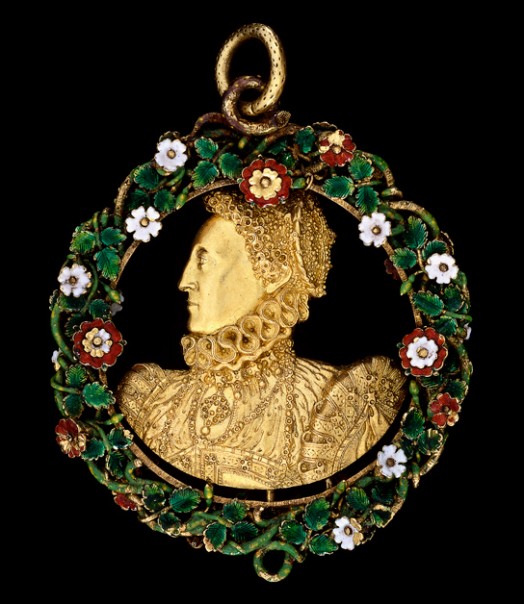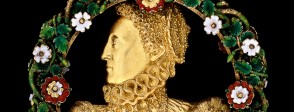
The Jewel
The Phoenix Jewel is made of gold and measures 4.5 cm in diameter. A delicate chain or cord was threaded through the gold loop at the top so that the pendant could be worn around the neck. At the centre is a silhouette of the queen. The details in the portrait reflect Elizabeth’s taste for detailed embroidery, expensive jewels and elaborate headdresses. We cannot be certain about the exact date of the jewel, but the depiction of the queen is very similar to a miniature portrait of Elizabeth painted by Nicholas Hilliard in 1572. The queen is surrounded by entwined red and white roses symbolising the consolidation of England under Tudor rule. The white rose was also a symbol of purity associated with the Virgin Mary. The back of the jewel depicts a phoenix in flames under the royal Monogram ER with the crown and heavenly rays above. The phoenix was a mythical bird representing renewal. As a self-perpetuating creature it also represented chastity.
The queen’s jewels
Queen Elizabeth I had a great love of jewels and during her reign she amassed a vast collection. Very little of her jewellery collection survives as most was sold or given as gifts by James I and Charles I Some jewels came to her as gifts from suitors, as bequests or as loot from Spanish ships. However, the majority of the queen’s jewels came in the form of gifts from courtiers and ambassadors. At the customary presentation of gifts to the queen on New Year’s Day, many courtiers chose to present Elizabeth with jewels. One of the queen’s favourite courtiers, Robert Dudley, started the ritual of welcoming the queen to his country house with the gift of a jewel, and of presenting Elizabeth with another jewel as a keepsake on her departure. The queen’s progresses - her summer visits to the houses of the nobility - became an important source of new jewels.
The Elizabethan court
The large community of Elizabeth’s advisers, government officials and ladies-in-waiting who served the queen at Whitehall, Greenwich and other royal palaces was known as the court. It was in the court that the Phoenix Jewel would have been worn. The court was the centre of royal power and patronage. The processions, jousts, hunts, masques, music, plays, poetry, feasts and religious ceremonies were performances in which the queen was praised and glorified. Courtiers knew that their success depended on attracting the attention of the queen. This could lead to titles, estates, export licenses and monopolies that would enhance their wealth and status. Gift-giving was an important aspect of preferment-seeking. As well as receiving gifts, the queen also gave them to favoured courtiers. This was an important way of securing their loyalty. A New Year’s Gift Roll, preserved in the British Library, records the astounding array of gifts received and presented by the queen on January I 1588.
Representations of the Queen
Elizabeth’s right to rule was asserted through a wide range of visual representations. As well as being depicted on jewellery, hundreds of portraits of the queen were painted during her lifetime. Many of Elizabeth’s subjects would have been familiar with representations of the queen from cheaply printed woodcuts or from engravings that appeared in illustrated ‘broadsheets’. Unlike Henry VIII and Mary I, Elizabeth never appointed a royal painter. Instead, she relied upon key courtiers to commission portraits on her behalf. A proclamation of 1563 prevented the circulation of unapproved images of the Queen. A face pattern was produced which artist were compelled to use in order to have their portraits approved.
In the early 1570s, the artist Nicholas Hilliard, began making limnings (miniature portraits) of the Queen. These were not accurate portrayals of her changing features, but representations of a fair and virtuous face. However, Hilliard devoted much care to the accurate depiction of the Queen’s elaborate jewels and the surface decoration of her dresses. Around 1575, he painted two large portraits of Elizabeth: the Pelican Portrait and the Phoenix Portrait. Both were named after the jewel worn by the queen in each image. Hilliard’s portraits mark the beginning of a period that would last until her death in which the queen’s body became a symbol of female virtue.
More information
The Phoenix Jewel on the British Museum website
http://www.britishmuseum.org/explore/highlights/highlight_objects/pe_mla/t/the_phoenix_jewel.aspx
Background on the reign of Elizabeth I
http://www.bbc.co.uk/history/people/elizabeth_I/
An introduction to the reign of Elizabeth I
http://www.bbc.co.uk/history/british/tudors/elizabeth_i_01.shtml
An introduction to Nicholas Hilliard’s portrait miniatures of Elizabeth I
http://www.bbc.co.uk/history/british/tudors/elizabeth_portrait_01.shtml
National Portrait Gallery article on the changing appearance of Elizabeth
http://www.npg.org.uk/research/face-to-face-articles-in-focus/16th-century-articles/concealed-and-revealed-the-changing-faces-of-elizabeth-i.php
Exploring Elizabeth
A National Portrait Gallery resource for using the Coronation Portrait and the Ditchley Portrait.
http://www.npg.org.uk/learning/digital/history.php
Step into the Frame
A National Portrait Gallery resource for using Tudor and Jacobean portraits.
http://www.npg.org.uk/learning/digital/teachers-notes/teachers-resources-history.php
More information
-
The Phoenix Jewel on the British Museum website
Source: britishmuseum.org
-
Background on the reign of Elizabeth I
Source: bbc.co.uk
-
An introduction to the reign of Elizabeth I
Source: bbc.co.uk
-
An introduction to Nicholas Hilliard’s portrait miniatures of Elizabeth I
Source: bbc.co.uk
-
National Portrait Gallery article on the changing appearance of Elizabeth
Source: npg.org.uk
-
Exploring Elizabeth
A National Portrait Gallery resource for using the Coronation Portrait and the Ditchley Portrait.
Source: npg.org.uk
-
Step into the Frame
A National Portrait Gallery resource for using Tudor and Jacobean portraits.
Source: npg.org.uk


